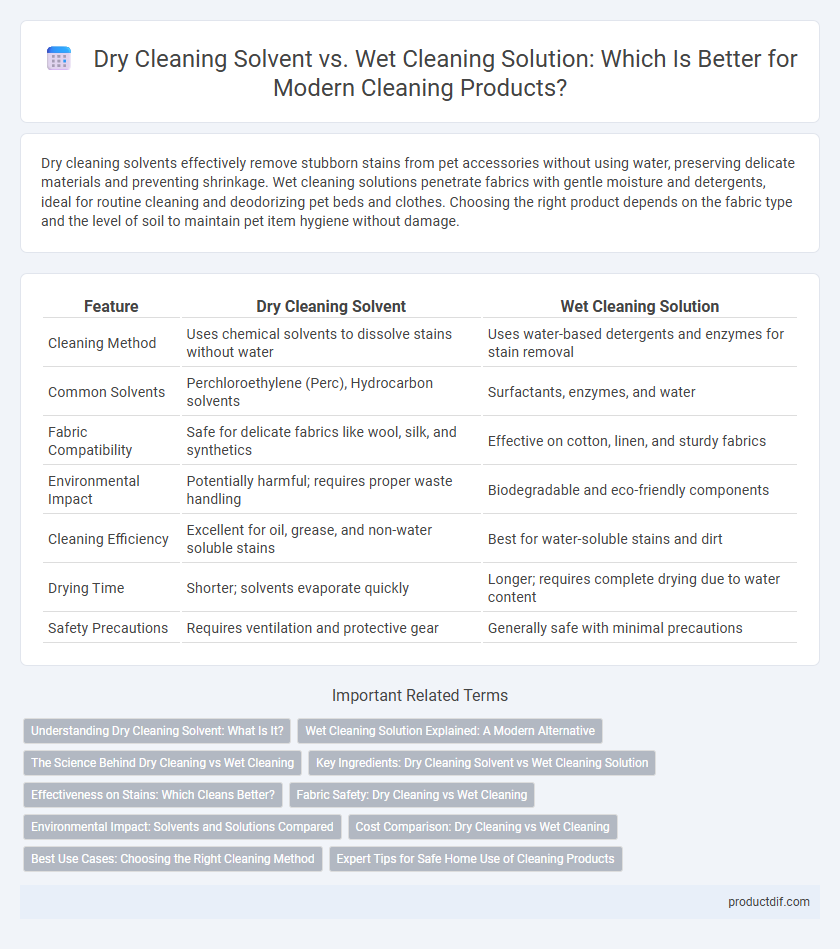Dry cleaning solvents effectively remove stubborn stains from pet accessories without using water, preserving delicate materials and preventing shrinkage. Wet cleaning solutions penetrate fabrics with gentle moisture and detergents, ideal for routine cleaning and deodorizing pet beds and clothes. Choosing the right product depends on the fabric type and the level of soil to maintain pet item hygiene without damage.
Table of Comparison
| Feature | Dry Cleaning Solvent | Wet Cleaning Solution |
|---|---|---|
| Cleaning Method | Uses chemical solvents to dissolve stains without water | Uses water-based detergents and enzymes for stain removal |
| Common Solvents | Perchloroethylene (Perc), Hydrocarbon solvents | Surfactants, enzymes, and water |
| Fabric Compatibility | Safe for delicate fabrics like wool, silk, and synthetics | Effective on cotton, linen, and sturdy fabrics |
| Environmental Impact | Potentially harmful; requires proper waste handling | Biodegradable and eco-friendly components |
| Cleaning Efficiency | Excellent for oil, grease, and non-water soluble stains | Best for water-soluble stains and dirt |
| Drying Time | Shorter; solvents evaporate quickly | Longer; requires complete drying due to water content |
| Safety Precautions | Requires ventilation and protective gear | Generally safe with minimal precautions |
Understanding Dry Cleaning Solvent: What Is It?
Dry cleaning solvent is a petroleum-based chemical used in the professional cleaning of delicate fabrics without water, effectively dissolving oils and grease while preserving fabric integrity. Common dry cleaning solvents include perchloroethylene (perc) and hydrocarbon solvents, both designed to remove stains without causing shrinkage or color loss. Unlike wet cleaning solutions, dry cleaning solvents evaporate quickly, reducing moisture exposure and minimizing fabric damage during the cleaning process.
Wet Cleaning Solution Explained: A Modern Alternative
Wet cleaning solution offers an eco-friendly alternative to traditional dry cleaning solvents by utilizing water-based formulations combined with biodegradable detergents. This modern approach effectively removes stains while preserving fabric integrity and reducing environmental impact from harmful chemicals like perchloroethylene. Advanced wet cleaning machines control moisture and temperature to deliver professional-grade results, making wet cleaning a sustainable choice for delicate fabrics and frequent garment care.
The Science Behind Dry Cleaning vs Wet Cleaning
Dry cleaning solvent relies on non-polar chemical compounds to dissolve oils and grease without water, preserving delicate fabrics that water could damage. Wet cleaning solutions use water combined with biodegradable detergents and controlled mechanical action to break down dirt particles while minimizing fabric stress. Understanding the molecular interactions in both methods highlights why dry cleaning excels in removing hydrophobic stains, whereas wet cleaning is effective for water-soluble soils and environmentally friendly textile care.
Key Ingredients: Dry Cleaning Solvent vs Wet Cleaning Solution
Dry cleaning solvent primarily contains perchloroethylene or hydrocarbon compounds, which effectively dissolve oils and grease without using water, making it ideal for delicate fabrics. Wet cleaning solutions utilize water-based detergents combined with biodegradable surfactants and enzymes to break down stains safely and efficiently on washable textiles. The choice of key ingredients influences the environmental impact, cleaning efficacy, and suitability for different fabric types between dry cleaning solvents and wet cleaning solutions.
Effectiveness on Stains: Which Cleans Better?
Dry cleaning solvents excel at removing oil-based stains such as grease, inks, and makeup due to their chemical composition that dissolves hydrophobic substances effectively. Wet cleaning solutions, leveraging water-based detergents and enzymes, perform better on water-soluble stains like coffee, wine, and food residues by breaking down organic matter. For comprehensive stain removal, selecting the appropriate cleaning method based on stain type ensures optimal fabric care and cleaning results.
Fabric Safety: Dry Cleaning vs Wet Cleaning
Dry cleaning solvents use perchloroethylene or hydrocarbon-based chemicals that gently remove stains without water, preserving delicate fabrics like silk, wool, and rayon from shrinkage or distortion. Wet cleaning solutions involve water and biodegradable detergents designed to safely clean garments with sensitive fibers, reducing the risk of chemical residue buildup. Choosing between dry cleaning and wet cleaning depends on fabric type, with dry cleaning preferred for structured garments and wet cleaning optimal for washable yet delicate textiles.
Environmental Impact: Solvents and Solutions Compared
Dry cleaning solvents often contain perchloroethylene (PERC), a chemical linked to air and groundwater pollution, raising significant environmental concerns. Wet cleaning solutions utilize biodegradable detergents and water-based processes, substantially reducing hazardous waste and chemical emissions. Choosing wet cleaning minimizes the ecological footprint by promoting safer, sustainable fabric care practices.
Cost Comparison: Dry Cleaning vs Wet Cleaning
Dry cleaning solvents typically incur higher costs due to specialized chemical usage and equipment maintenance, averaging $10 to $20 per garment. Wet cleaning solutions are more cost-effective, utilizing water-based detergents and standard washers, reducing expenses to approximately $5 to $10 per item. The cost disparity is influenced by solvent processing fees and environmental compliance associated with dry cleaning.
Best Use Cases: Choosing the Right Cleaning Method
Dry cleaning solvents are ideal for delicate fabrics and items that cannot tolerate water, effectively removing oil-based stains without causing shrinkage or color bleeding. Wet cleaning solutions are best suited for washable textiles, offering a safer, eco-friendly alternative that breaks down water-soluble stains and eliminates odors. Selecting the right cleaning method depends on fabric type, stain nature, and environmental considerations to ensure optimal care and longevity of garments.
Expert Tips for Safe Home Use of Cleaning Products
Dry cleaning solvents often contain strong chemicals requiring careful ventilation and protective gloves to prevent skin irritation and respiratory issues during use. Wet cleaning solutions, being water-based and generally less toxic, offer a safer option but still demand proper dilution and storage away from children and pets. Experts recommend always following manufacturer instructions, conducting patch tests on fabrics, and ensuring adequate airflow to maintain safe home environments while effectively removing stains.
Dry Cleaning Solvent vs Wet Cleaning Solution Infographic

 productdif.com
productdif.com